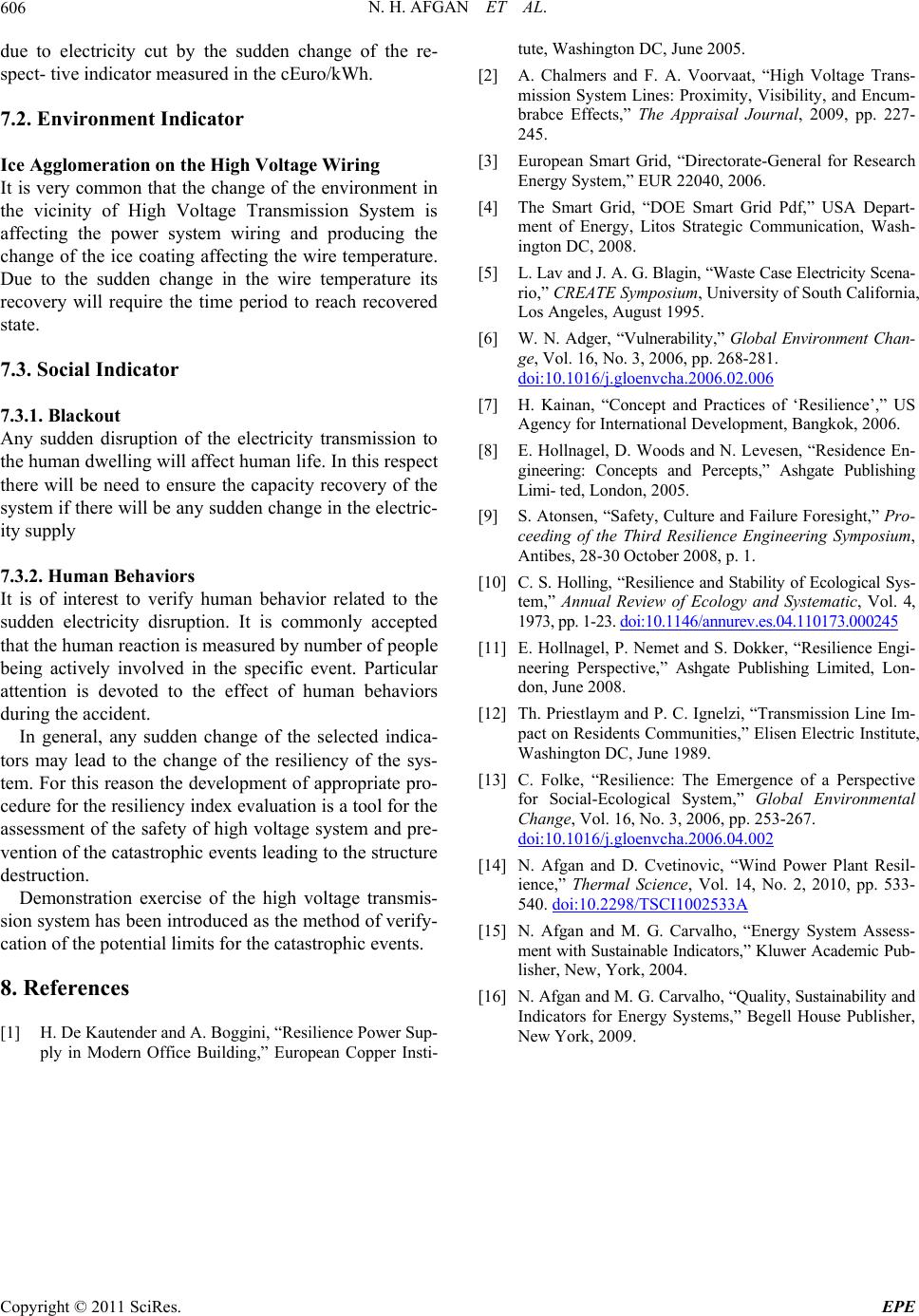
N. H. AFGAN ET AL.
Copyright © 2011 SciRes. EPE
606
due to electricity cut by the sudden change of the re-
spect- tive indicator measured in the cEuro/kWh.
7.2. Environment Indicator
Ice Agglomeration on the High Voltage Wiring
It is very common that the change of the environment in
the vicinity of High Voltage Transmission System is
affecting the power system wiring and producing the
change of the ice coating affecting the wire temperature.
Due to the sudden change in the wire temperature its
recovery will require the time period to reach recovered
state.
7.3. Social Indicator
7.3.1. Blackout
Any sudden disruption of the electricity transmission to
the human dwelling will affect human life. In this respect
there will be need to ensure the capacity recovery of the
system if there will be any sudden change in the electric-
ity supply
7.3.2. Human Behaviors
It is of interest to verify human behavior related to the
sudden electricity disruption. It is commonly accepted
that the human reaction is measured by number of people
being actively involved in the specific event. Particular
attention is devoted to the effect of human behaviors
during the accident.
In general, any sudden change of the selected indica-
tors may lead to the change of the resiliency of the sys-
tem. For this reason the development of appropriate pro-
cedure for the resiliency index evaluation is a tool for the
assessment of the safety of high voltage system and pre-
vention of the catastrophic events leading to the structure
destruction.
Demonstration exercise of the high voltage transmis-
sion system has been introduced as the method of verify-
cation of the potential limits for the catastrophic events.
8. References
[1] H. De Kautender and A. Boggini, “Resilience Power Sup-
ply in Modern Office Building,” European Copper Insti-
tute, Washington DC, June 2005.
[2] A. Chalmers and F. A. Voorvaat, “High Voltage Trans-
mission System Lines: Proximity, Visibility, and Encum-
brabce Effects,” The Appraisal Journal, 2009, pp. 227-
245.
[3] European Smart Grid, “Directorate-General for Research
Energy System,” EUR 22040, 2006.
[4] The Smart Grid, “DOE Smart Grid Pdf,” USA Depart-
ment of Energy, Litos Strategic Communication, Wash-
ington DC, 2008.
[5] L. Lav and J. A. G. Blagin, “Waste Case Electricity Scena-
rio,” CREATE Symposium, University of South California,
Los Angeles, August 1995.
[6] W. N. Adger, “Vulnerability,” Global Environment Chan-
ge, Vol. 16, No. 3, 2006, pp. 268-281.
doi:10.1016/j.gloenvcha.2006.02.006
[7] H. Kainan, “Concept and Practices of ‘Resilience’,” US
Agency for International Development, Bangkok, 2006.
[8] E. Hollnagel, D. Woods and N. Levesen, “Residence En-
gineering: Concepts and Percepts,” Ashgate Publishing
Limi- ted, London, 2005.
[9] S. Atonsen, “Safety, Culture and Failure Foresight,” Pro-
ceeding of the Third Resilience Engineering Symposium,
Antibes, 28-30 October 2008, p. 1.
[10] C. S. Holling, “Resilience and Stability of Ecological Sys-
tem,” Annual Review of Ecology and Systematic, Vol. 4,
1973, pp. 1-23. doi:10.1146/annurev.es.04.110173.000245
[11] E. Hollnagel, P. Nemet and S. Dokker, “Resilience Engi-
neering Perspective,” Ashgate Publishing Limited, Lon-
don, June 2008.
[12] Th. Priestlaym and P. C. Ignelzi, “Transmission Line Im-
pact on Residents Communities,” Elisen Electric Institute,
Washington DC, June 1989.
[13] C. Folke, “Resilience: The Emergence of a Perspective
for Social-Ecological System,” Global Environmental
Change, Vol. 16, No. 3, 2006, pp. 253-267.
doi:10.1016/j.gloenvcha.2006.04.002
[14] N. Afgan and D. Cvetinovic, “Wind Power Plant Resil-
ience,” Thermal Science, Vol. 14, No. 2, 2010, pp. 533-
540. doi:10.2298/TSCI1002533A
[15] N. Afgan and M. G. Carvalho, “Energy System Assess-
ment with Sustainable Indicators,” Kluwer Academic Pub-
lisher, New, York, 2004.
[16] N. Afgan and M. G. Carvalho, “Quality, Sustainability and
Indicators for Energy Systems,” Begell House Publisher,
New York, 2009.